I said to look out for a Flashpoint #2 review soon, didn’t I? Well, maybe this isn’t exactly “soon”, but that’s because this is much more than that! We’ve decided to do several Flashpoint updates, covering the event as it happens, mostly from my semi-clueless perspective. Today I’ll be covering both Flashpoint #2 and #3, as well as several of the tie-in issues that have come out recently.
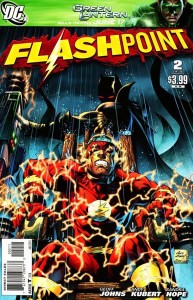
At this point there are more than twenty issues relating to Flashpoint available. I normally try to avoid giving away big spoilers, but it’s going to be almost impossible for these updates. If you don’t want anything spoiled, I’d advise you to read no further.
Seeing as there’s so much to cover this month, I’m going to be breaking this down into sections. First up, let’s take a look at issue #2 of the main book.
Flashpoint #2
Flashpoint #2′s cover depicts The Flash, strapped into an electric chair and out in the rain, with Batman in the shadows behind him throwing the switch. My first thought when seeing it was to ask myself if this was how Barry planned to recover his powers, or whether it was purely metaphorical. This strikes me as being another simple cover, though in a slightly different way to the one before it; like the one before it, though, it features The Flash himself prominently. There isn’t a lot else going on, and the only other character in view is in the background. If you ask me, it’s the second cover in a row to be good at grabbing your attention, and it’s drawn really well. This cover was done by Andy Kubert and Sandra Hope.
The second issue of Flashpoint picks up where the first left off. Having no one else to turn to in this strange new version of history, Barry drove himself to Gotham and snuck into a rather sparse looking Batcave. He’s soon confronted by a very untrusting Batman, whom he tries to convince was his friend in the universe he’s from. But Barry’s made a miscalculation, which was the twist at the end of issue #1: in this world, Batman is not Bruce Wayne—he’s Thomas Wayne. Barry quickly realizes that in this history, it was Bruce who was killed in Crime Alley, leading to his father’s personal war on crime.
This new version of Batman wastes no time breaking bones and tossing Barry around, obviously not believing his rantings about being from another world. That is, until Barry’s senses are suddenly overwhelmed with new memories—the memories he should have had if he was the Barry Allen of this world. He realizes that his mind is changing to fit the new reality, and that can mean only one thing: it isn’t an alternate world, but his world, changed. And if he doesn’t act fast, he may just forget that history has been changed at all.
For some reason, after these mental flashes, Barry’s Flash ring seems to drop to the floor, apparently from his person. Seeing it as his chance to prove to Batman he’s been telling the truth, Barry explains how it contains his costume and shoots it out to show him. But it isn’t his costume that pops out; it’s the costume of Professor Zoom—the Reverse-Flash. Barry believes this is Zoom’s way of telling him that he’s responsible for the changes in the timestream, which certainly isn’t out of the question given his past exploits. Finally beginning to believe that the intruder might not be completely crazy, Dr. Wayne gives in and goes along with Barry’s…well…completely crazy plan to get his powers back. This involves strapping Barry into the electric chair from the cover, on the roof of Wayne Manor, in the middle of a thunderstorm, with beakers of the appropriate chemicals balanced all around him—in other words, completely recreating the accident that gave him his powers in the first place. The twist at the end of this issue is that it ends exactly how you’d expect it to end if this weren’t a comic book…
The bulk of this issue is about the interactions between these two characters, but we do cut away from them a couple of times—first to see Aquaman and then to see Wonder Woman. The Sea King makes his appearance at the beginning of the issue, attacking Slade and some other assorted villains when their pirate ship drifts too close to Paris, which is now underwater. The Themyscirian princess is introduced later in “New Themyscira”—which used to be Britain; we learn through her interrogation of Steve Trevor (who in other universes had been her love-interest, ironically) that everyone’s favorite reporter, Lois Lane, has been spying on the Amazons for Cyborg.
As I already said, Barry still doesn’t get to become The Flash in this issue. I was still sort of disappointed by that when I first read the issue, but at the same time, I felt like I was starting to get an idea of what sort of pace the story was going for. This is only issue 2 of 5, after all; you could say that we’re only just getting past the beginning of the story, with the middle on its way in issue #3. Issue #1 introduced us to the concept and kept us as blind and confused about the new world as Barry himself, while this issue fleshed out the Flashpoint Earth more and explained some of what’s going on, once again leaving me curious about what will happen next.
Andy Kubert is once again the artist in this issue, and his art continues to please me consistently. I think this issue’s visual highpoint is a two page spread of what used to be Paris; now little more than a ship’s graveyard, the ruined tip of the Eiffel Tower jutting up above the waves hints at how much Europe has been flooded—although it’s an extra at the back of the issue that reveals the true extent of this.
This issue also gives us our first good look at Wonder Woman and Aquaman’s Flashpoint designs. Aquaman’s is pretty good, sporting what looks vaguely like a red and black version of his normal costume and wearing a constantly serious expression on his scarred face; after seeing his pre-war design in a later issue, I’ve come to appreciate this one a bit more. But of the two, it’s Wonder Woman’s I find more interesting; her Flashpoint counterpart wears full warrior’s armor that is very different from the costume we’re used to, or even from her more recent costume (yes, the one with the pants). I quite like it.
Both of these new designs are by Andy Kubert himself, and further details about them—as well as details about the designs of Flash, Batman and Cyborg—are found as extras at the end of this issue. It’s clear when you look at these notes that Mr. Kubert put some thought into the finer details on each costume, some of them being things I wouldn’t have noticed in the panels of the comic itself.
Another nice little extra is a map of the Flashpoint Earth, illustrated by Freddie Williams III. It shows all the territories and war zones, as well as the extent of the flooding. If issue #1 was to introduce the concept and issue #2 was to flesh it out, I think this was the perfect time to throw in something like this. Like Barry himself, we’re just starting to get an idea of what this new world is like. I’m also quite pleased to see that New Zealand—which is where I live right now—is part of the neutral territories!
With issue #2 out of the way, I was ready and eager for more. However, I think it’s safe to say that I underestimated the scale of a DC event. By the time issue #3 of the main book was out, about twenty tie-in issues had been released as well. It’s been quite a task going through and summarizing them all, but here they are—Flashpoint’s first batch of tie-ins.
The Tie-Ins

First up is Batman: Knight of Vengeance, of which two issues have currently been released. This comic serves to flesh out the alternate dark knight more, showing us just how different he, his allies, and his enemies are from the world we knew. Plot wise, these three issues seem to be covering the case of the abducted Dent children, which was mentioned, and still unresolved, back in issue #1 of the main book. Thomas Wayne makes an older, gruffer Batman, but apart from one big thing at the end of issue #2, I don’t think the story really adds a lot we didn’t already know about him. The rest of the cast are another matter, with almost every role being quite different from the regular timeline. The story takes a dark and bloody turn towards the end, finishing on another major plot twist.
Both issues were written by Brian Azzarello and illustrated by Eduardo Risso, and I found them quite intriguing. I think my only criticism would be that the covers seem very forgettable to me.

Abin Sur: The Green Lantern #1 came out around the same time as issue #1 of Knight of Vengeance. My first thought was that the cover looks much like an old science fiction movie poster, which I like. The story begins with us being introduced to Abin as a child, learning from his sister that he should respect all life, no matter how small or seemingly insignificant; we then cut ahead to Abin, grown up and in the Green Lantern Corps, fiercely dismembering a Manhunter robot while yelling, “You are not alive!” Once again, the reader learns through the dialogue that this is a very different world: the Black Lanterns are still running wild, Kilowog is dead, Sinestro is still a Green Lantern, and both Abin’s sister and his homeworld Ungara have been lost. The Guardians charge Abin with retrieving the White Entity from Earth before the planet destroys itself with war and fear. While he makes his way to our doomed little world, Sinestro visits Atrocious and asks him a surprising question, hinting that the Red Lantern might know more about this whole big event than we do!
The issue is written by Adam Schlagman and drawn by Felipe Massafera. The art is of very high quality and has an impressive amount of detail. My overall thought on the issue was that Abin Sur seemed surprisingly violent and insubordinate, but I suppose you can’t blame him after losing his home and his sister.
The second issue begins with a flashback showing Abin training with Sinestro, as well as Sinestro meeting Abin’s sister, who would be his wife in the main continuity. We then return to the present, where Abin has crashed after being shot down by us humans…some advanced alien he turned out to be. He is found by Hal Jordan, but he’s pushed out of the way almost immediately by Cyborg, and Abin is taken away by the government. It doesn’t take him long to break out of his containment tank, however, and he quickly agrees to join Cyborg in trying to save the world, even though the Guardians threaten to take away his ring if he does so. While looking for survivors in Europe, Abin is met by Sinestro; initially thinking he’s there for his ring, it turns out he’s learned of the Flashpoint Prophesy from Atrocious, and describes it as an event in time that changes everything moving forward. He’s also learned that The Flash can put everything back as it was, and thus if he controls The Flash’s power, he can put it back better than it was, so that Abin and his sister are alive in the new timeline. Abin believes Sinestro’s mind has been poisoned by Atrocious’ lies, and knowing he can’t succeed while Abin lives, Sinestro bluntly goes on the attack.
I thought the first issue was a little fast paced, but the second feels outright rushed to me. Hal Jordan’s in it so briefly before being told to go away, Abin joins Cyborg in the shortest conversation possible, and Sinestro resorts to attacking Abin with such little provocation. On the other hand, I am curious about how Atrocious knows about Flash’s role in all this. The art is by Robson Rocha, Felipe Massafera and Joe Prado, and is definitely the issue’s strongest point. Felipe Massafera once again provides a stylish cover.
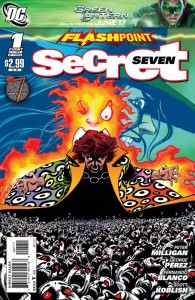
At first I thought Secret Seven was a comic I knew nothing about, having never a Secret Six comic…but as it turns out, the two apparently have absolutely nothing in common anyway. The cover alone makes it stand out from other current DC comics, looking quite psychedelic with Shade—our main character—looming over screaming, red eyed heads. It’s crazy…but actually, rather fitting once you’ve been introduced to the guy. Indeed, his first appearance in this issue has him reminding himself that while his hallucinations aren’t real, he is real; that’s not really something most people would forget. Shade has reality warping powers that stem from his “Changing Vest”, an item of alien origin. His is going a little wrong, however, and his insanity isn’t helping matters. This all results in an issue that’s sometimes like watching a trippy music video…and I have to say, I enjoyed it. The art is very colorful and, in a way, slightly more cartoony than the other DC comics I’ve been reading lately. Written by Peter Milligan and pencilled by George Pérez, this was a fun one to check out.
Issue #2 has another cover by George Pérez, with the same screaming heads as the first, but this time with Amethyst and Abra Kadabra instead of Shade. The rest of the issue is laid out by Fernando Blanco and finished by Scott Koblish, resulting in a somewhat less cartoony style than the first. I didn’t find this issue as much fun, personally; in fact, I mostly just found it even more confusing. Shade’s vest seems to be causing trouble left and right, possibly due to his increasing madness…or maybe the madness is due to the vest? Whatever the case, despite gathering two members of the Secret Seven without really meaning to, Shade seems no closer to leading a team and helping Cyborg than when the story started. The issue ends with Mr. Kadabra, apparently believing Shade is dangerous—which probably isn’t wrong—revealing the identities of the Secret Seven to the world, followed by another confusing twist right at the end. This one definitely wasn’t as fun for me as the first, and with only one more issue to go, I can’t imagine that this team is actually going to do anything to help the world; at most I think they might just save it from Shade’s broken vest.
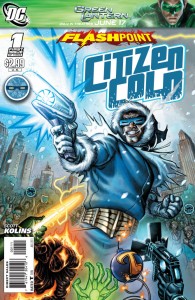
Citizen Cold #1 provides some backstory for this universe’s Leonard Snart, a.k.a. Captain Cold. In the Flashpoint timeline, Cold fancies himself some kind of hero, and is apparently Central City’s greatest. That’s to the public, at least; if anything, Cold might actually be more villainous here than in the old timeline. Rather than simply stopping criminals, he lures them to his city with false information so he can defeat them and increase his popularity, and he seems to have no problem with killing them outright to boot. This first issue does a good job of letting us see into Snart’s mind, and he’s an interesting character to say the least. We also see a lot of familiar faces from Flash’s comics, including a lot of his rogues—now Cold’s rogues. The issue was written and drawn by Scott Kolins. The art has a good level of detail. It’s a strange thing to mention and not something I’d normally notice or comment on, but the panel layout was also really well done.

Issue #1 of Deathstroke and the Curse of the Ravager gives us a closer look at that ship (the titular Ravager) full of assorted bad guys from Flashpoint #2. They’re modern day pirates with Deathstroke as their captain, taking advantage of the chaos the world is in for their own profit. But Captain Slade himself only seems interested in one treasure in particular: his missing daughter. This issue seems like a bit of a wild goose chase, with the pirates following the girl’s trail only to always be one step behind. There’s a lot of action and bloody combat, which you’d probably expect after seeing the cover. This issue was written by Jimmy Palmiotti and pencilled by Joe Bennett; I feel the bright coloring work by “The Hories” deserves a mention as well.
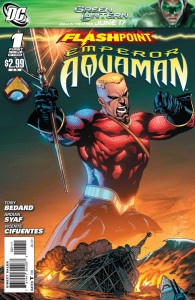
Emperor Aquaman #1 is an issue that answers some of the questions people have had about the Flashpoint world. In fact, most of the issue is backstory. We learn that Diana and Arthur were to be married, and are told through the dialogue that Aquaman had her mother assassinated on their wedding day, kicking off the war. We also learn that Themyscira was destroyed and that the Amazons took over Great Britain soon after. The final reveal, which the issue more or less revolves around, is the how and why of Aquaman sinking western Europe; the twist of what fuels his weapon of mass destruction is a little predictable, but nonetheless unsettling. My only real complaint is that the narrative jumps around a lot, showing us “10 months ago”, then the present, then “8 months ago” seemingly randomly. I’m also not that fond of Ardian Syaf’s cover, but his art for the rest of the issue is very good, with lots of detail. The issue was written by Tony Bedard.

Written by Jeff Lemire and drawn by Ibraim Roberson, Frankenstein & the Creatures of the Unknown is one of the oddest titles for a comic I’ve ever come across. The comic itself is pretty bizarre, too. Towards the end of World War II, the Americans happen to discover Frankenstein’s monster buried in ice somewhere in the North Atlantic. Sensing evil in the Germans, the monster—simply going by Frankenstein here—joins the Allies in their fight. This first issue is pretty fast paced, the story skipping ahead years every other time you turn the page. The “creatures” mentioned in the title are super soldiers, supposedly based on Frankenstein himself and inspired by other classical monsters; along with Frankenstein, they fight for the freedom of the world, but are all betrayed by the American government when the war ends. Frozen in cryogenic suspension, the group awakens and escapes in the present day, leaving issue #2 to deal with what effects their presence will have on the modern Flashpoint world.
Personally, I think this first issue might have had a bit too much crammed into it. You can’t really blame the writers when they have to fit the whole story into three very short issues, but I felt like I barely got a chance to know the characters. Most of them didn’t even get a single line of dialogue before being shoved into suspended animation tubes. We’re told that Griffith, the wolfman, can’t even form a sentence anymore following their long sleep, but I wouldn’t have known that was anything new since he never got to utter a word before that point. Still, the fast pace did cause some unintentionally funny moments, such as how dang quickly and easily they beat the Nazis. There’s also an interesting moment when they’re escaping from the lab under Metropolis and pass a giant, broken vault with Superman’s shield on it; this is our first hint at where this timeline’s version of Superman has been. Roberson’s art is very polished, and despite them being classical monsters, the designs of Frankenstein and the creatures are unique. Doug Mahnke’s cover isn’t quite up to the standard of the art within, but it’s striking and brutal nonetheless.
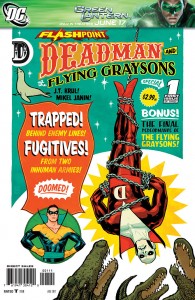
Deadman and the Flying Graysons #1 introduces us to this world’s Deadman, a.k.a. Boston Brand, and Dick Grayson, a.k.a….well…he’s not Robin in this reality. It was only when I remembered Deadman was originally an acrobat in life that this match up made sense to me. The two, along with the rest of the Grayson family, are performers in a travelling circus that found itself stranded in eastern Europe when Aquaman sank the west. The circus continues to travel, trying to bring some smiles to the bleak little world of Flashpoint. This issue kind of feels like the opposite of Frankenstein and the Creatures of the Unknown #1; where that rushed through action scenes very quickly, this book spends its entire first issue introducing the characters. There’s very little in the way of actual action in this one, but the cliffhanger ending hints at a lot coming in issue #2. I feel that this pays off and actually works better, and I was intrigued by the interactions between the characters all the way through the issue. J.T. Krul, the writer, does a great job of making the characters compelling, and there’s some simple yet really good dialogue between Dick and Boston towards the end of the issue. Mikel Janin’s artwork is of very high quality throughout, and the cover by Cliff Chiang and Jared Fletcher looks almost like something out of the Silver Age.
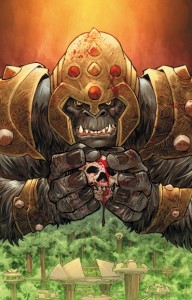
The first one-shot of the tie-ins is Grodd of War, which details the modern life of Guerilla Grodd in the Flashpoint world. The cover, drawn by Francis Manapul, shows Grodd in war armor holding a bloody, human skull; Manapul is a great artist, and this cover is by no means bad, but I find it a little forgettable. The rest of the issue is sort of a mixed bag. The premise is interesting, with Grodd growing bored of his peaceful rule after conquering all of Africa. He takes his violence out on whomever he can, and even seems to let enemies go so that they might return for revenge at a later date, as if he’s always looking for a challenge. There are some parts, however, that a casual comic fan like myself just didn’t get. I never would have known who Congorilla was without looking him up, and without knowing he was already an established character, his brief appearance in the issue was confusing and seemed pointless; on the other hand, perhaps I should have guessed that a character with such an elaborate backstory wasn’t created just for this.
Sean Ryan’s writing here is simple…or should I say subtle? It doesn’t ram explanations down your throat. Grodd doesn’t monologue or overly explain his feelings to the reader, yet Ryan’s writing and Ig Guara’s art do a good job of conveying them anyway. It’s definitely a well done comic, but…like the cover, I don’t find it very memorable in the end. No one in the Flashpoint world seems to care that Grodd’s taken over Africa, and with everything else that’s going on in their world, maybe I find it a little hard to care, too.
Sorry, Africa… That’s pretty mean of me…
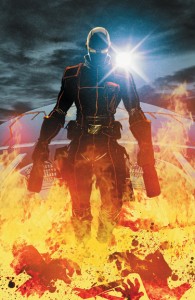
Legion of Doom #1 does a good job of subverting expectations. The issue follows the incarceration of Heatwave, a.k.a. Mick Rory, after he murders Jason Rusch in a crazy bid to become the superhero Firestorm himself, a desire sparked by his obsession with fire. We see him on death row, and around that point, I started to wonder what this had to do with the Legion of Doom. As if on queue, the comic cuts to the classic Hall of Doom rising out of the swamp…but it’s not what you expect. In the Flashpoint world, the Hall of Doom is death row—a high security prison owned by “Green Arrow Industries”, and the place Mick had been imprisoned all along. He doesn’t plan on sticking around, however, and enlists Cluemaster—a Batman villain—to smuggle a very surprising package in for him…with gruesome results. Rooney Buchemi’s art varies a bit from page to page, but on the whole is very good, with some of the more brutal moments (such as Jason’s death) being rather cringe worthy. The dialogue seemed pretty average to me, however.

World of Flashpoint #1 has a pretty fitting cover, depicting the star of the issue sitting with the Flashpoint Earth in her lap; drawn by Brett Booth and Andrew Dalhouse, it’s simple yet eye-catching. The story, written by Rex Ogle, follows the life of this reality’s version of Traci Thirteen, a “Homo Magi” (that is, a human born with inherited magical powers) who was just trying to have a normal life learning witchcraft from her mother. Unfortunately, her family happened to live in Paris, and I think we all know by now what happens there… Traci and her father escape Aquaman’s tsunami thanks to her magic, but she isn’t powerful enough to save her mother or brothers. The guilt and regret weigh heavily on both of them, straining their relationship; several months later, Traci secludes herself refining her magical gifts, while her father turns to the H.I.V.E. organization in an attempt to save the world, no matter the cost. Both father and daughter have their own ideas of how they should help the world and what sort of price peace is worth, but it seems to me that both are using their respective ways as an escape from the tragedy they have suffered. The issue ends with their ideals clashing in an explosive way when her father and H.I.V.E. decide to blast New Themyscira off the map with a satellite weapon, leaving only Traci to try to stop them before they murder millions of people. This issue has some good emotion in it, as well as a few appearances from characters we haven’t seen in the Flashpoint world up to now.
Speaking of cameos, Traci pays a visit to Madame Xanadu, one of DC’s mystic Arthurian characters. Her crystal ball provides us with yet more backstory, mentioning the Justice Society and how they failed, falling because they lacked someone “faster”. Does this mean Jay Garrick didn’t become The Flash in this world either? Has this world never had a Flash? We also see that an alien craft fell on the city of Metropolis some time ago, apparently proving fatal to the inhabitants; the stylized “S” on the side makes it even more obvious whose ship this was, and while it explains why there’s no Clark Kent/Superman around, it leaves us wondering just what could have caused the spaceship to touch down in such a different place.
World of Flashpoint #2 begins with a cover by Brett Booth, Norm Rapmund and Andrew Dalhouse. This time Traci is floating amongst unique tarot cards, with the Flash logo on the back and various characters from the Flashpoint world on the front; not only did I love this cover immediately, but I want that deck. In this issue, Traci narrowly escapes from H.I.V.E headquarters after being drugged by her own father, returning to her mentor, Madame Xanadu. Unfortunately, she seems to be on the verge of death—something she’d predicted in the previous issue—and can only advise Traci to let her tarot cards guide her around the world, to let her see why it’s worth saving and then show her father the same. Almost the whole issue has Traci teleporting around the world, meeting the Flashpoint versions of other DC characters such as Red Tornado, Guy Gardner, and Jason Todd…who has a surprising occupation in this reality. Traci is disappointed that no one she meets will join her and help, but in the end, that wasn’t what Madame Xanadu told her to do. The issue ends with her going back to face her father, who appears to have a few surprises up his sleeves.

Issue #1 of Lois Lane and the Resistance begins with more valuable exposition. We’ve already learned that an Atlantean assassinated Diana’s mother, but here we find out that the Amazons themselves destroyed and sank Themyscira in an attempt to kill Aquaman and other members of the ruling class of Atlantis, who were all on the island at the time. These two enormous events, as well as the Amazon occupation of the United Kingdom, all happened within the space of of a measly three months; the issue’s story begins nine months later, with Aquaman sinking western Europe. Reporting in Paris at the time of the disaster, Lois Lane and Jimmy Olsen soon find themselves fleeing from the resulting tsunami; Lois survives by taking refuge with a priest at the top of the Basilica of Sacré-Cœur, but Jimmy is tragically killed as he heroically tries to help an old man. Soon rescued by the Amazons and taken to England, Lois is surprised to find that Jimmy’s camera is actually a high tech communicator, providing a direct link Cyborg. Yes folks, Jimmy Olsen was some sort of secret agent, and Lois jumps at the chance to pick up where he left off, becoming an informant behind enemy lines.
This is an interesting issue because it gives us our first real look at what New Themyscira is like—and it’s a pretty dark place. Non-Amazonian women are offered re-education seminars, and anyone who refuses to subscribe to their beliefs is sent to some kind of concentration camp; given that they refused to save a Christian priest earlier for his belief in a “false god”, I guess this policy isn’t too surprising. The Amazons are apparently even recruiting civilian women, attempting to give them Amazonian strength through some unrevealed process, though the success rates are low and the consequences of failure are pretty dire. All in all it’s an intriguing issue, drawn competently by Eddie Nunez and written by both Dan Abnett and Andy Lanning.

The Canterbury Cricket is another candidate for the weirdest title ever award—and that’s coming from somebody raised in Britain. This story, written by Mike Carlin, gives us our first introduction to the titular character. It begins with the British Resistance—made up of Etrigan the Demon, Godiva, Mrs. Hyde and Wicked Jinny Greenteeth—fighting for their lives against the Amazons; the group is saved in the nick of time by our hero, who can only be described as an enormous cricket. The large insect man, apparently being a very patriotic Brit, joins their cause in a heartbeat, and the rest of the issue is mostly him explaining his peculiar origins to the group. Despite it being almost entirely backstory and character interactions, there’s a fair sprinkling of action in this one, and the way the characters talk with each other is pretty good as well. Honestly, how can talking with Etrigan not be interesting? The issue’s art is done by Rags Morales, another great artist who draws some wonderful facial expressions, especially when it comes to Etrigan. The cover is by both Morales and Ruffino, and it matches the inner art very well. Using the colors of the Union Jack for the title text was a nice touch.
Being British myself, I was asked if anything about this comic seemed strange to me, or if England had been misrepresented. The only thing I can think of worth mentioning is that the Cricket seemed to speak very proper, formal English throughout the entire issue, but then blurts out, “Ruddy hell!” on the last page, which just doesn’t strike me as something a person with formal speech patterns would say. Maybe it was intentional.
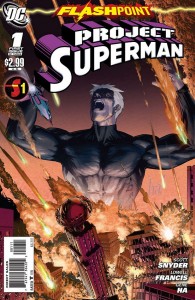
Project Superman is a tie-in starring a character named Neil Sinclair, a man who volunteers for Sam Lane’s project to create…well…a superman—not a surprising goal when the Amazons and Atlanteans are already supermen/superwomen. Neil is infused with alien DNA from the mysteriously named “Project Six” (whom I’ll get to later in the article) and gains the power to adapt to basically anything. The more tests they put him through, the more super-powered he becomes…but is he trustworthy? Lane begins to keep more of a distance from him and seems like he might have moved on to other projects; perhaps as a result, Sinclair begins keeping certain powers such as x-ray vision and super hearing to himself. Still wanting Lane to see him as a success, he continues to push himself, but they seem to decide he was a mistake after all when he slaughters everyone during a mission, including his own support team. The issue ends with Neil locked down in the facility, just as Metropolis is devastated above by the arrival of a familiar alien baby—just as Madame Xanadu had told us. This issue, written by Scott Snyder and Lowell Francis, is okay, but I’m far more interested in where the story will go from here than what has happened so far. Gene Ha is the artist, using a style that seems almost…how should I say it…old school? He also provides the cover, which depicts Sinclair standing over Metropolis as it’s hit by a meteor shower—the arrival of you-know-who!

Hal Jordan #1 of 3 has a nice cover by Rags Morales and Gabe Eltaeb, with Hal against a blue-sky background and three jets flying by in the foreground. The art, provided by Ben Oliver, is very detailed and realistic compared to most of the other books. The story gives us the normal Hal Jordan backstory—how his father was a pilot and died in a crash, yet Hal still became a pilot anyway. In this reality, Hal and Carol Ferris were drafted to fly planes as part of a coastal patrol; this leads to their planes being attacked by some kind of man shark of all things, and Hal shows off his normal reckless side, wrecking their expensive aircraft and getting himself in trouble. But this doesn’t stop him from flying off in another plane without permission, and as he flies, he encounters someone as reckless and insubordinate as him: Abin Sur. More specifically, he witnesses Abin being shot down by a purple beam of some sort—which I still don’t know the origin of—and lands to see if he’s okay. This ending ties in with the second Abin Sur issue I looked at earlier. To be honest, I think the issue felt as rushed as Abin Sur #2 thanks to things like a complete lack of transition between Hal taking off and seeing Abin shot down; I almost thought it might be written by the same person, but the writer for this one was Adam Schlagman. Still, since we know Hal doesn’t get the ring from the Abin Sur issues, it’ll be interesting to see where they’re going with this one.
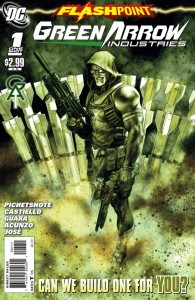
Green Arrow Industries #1, written by Pornsak Pichetshote and drawn by both Marco Castiello and Ig Guara, introduces us to quite a different Oliver Queen. In the normal timeline, Ollie is the guy who stands up for the little people and is one of DC’s most left-wing characters; here, though, he’s the head of the faceless Green Arrow Industries corporation and very literally couldn’t use a bow to save his life. The company is apparently named after the missiles they create rather than a superhero and makes all of its money reverse engineering and repackaging supervillain weaponry. I suppose this explains Ollie’s Legion of Doom prison to an extent. In this issue, assassins break in and kill all of Queen’s staff, including Roy Harper and several generals who were visiting. Oliver follows the only surviving intruder, armed not with a bow, but weapons and gadgets from various DC villains. He ends up in a fight against the much more skilled female assassin and learns what he’d done, whether he meant to or not, to earn the anger of the group; as it turns out, the research centers studying the equipment of villains had been devastated by those very bad guys when they came looking for their property. Not only does this issue end in tragedy, but it’s a one shot as well, so there’s no chance for a happy ending here. As a fan of Green Arrow, it’s pretty disheartening to see Ollie as hopeless and lost as he is here. It does come with a fantastic cover by Viktor Kalvachev, however.

The Outsider #1 gives us our first real introduction to The Outsider himself…and I mean ever, because he didn’t even exist before his appearance in Flashpoint #1. The issue’s story begins in Chandigarh, India, the year 1960, where a woman is giving birth. The baby is unusual, however, and she doesn’t survive the delivery; when the father rejects the strange child, no one else in Chandigarh survives, either, the entire city being engulfed in some sort of unexplainable disaster, leaving only the baby alive at its center. Years later this child, given the name Michael Desai by an orphanage he ran away from, has grown to acquire wealth, power, and fancy business suits. This first issue establishes the character as a generally calm, intelligent, and rather charismatic individual, and despite him being a bad guy, I find it kind of hard not to like him. He seems to have his fingers in many illicit pies, and after an introduction that lets us see another side to a scene from Flashpoint #1, the rest of the issue involves one of those pies coming back for revenge. Fans of Mr. Terrific may not like how this one ends.
This issue, written by James Robinson, is a good balance of characterization and action—a fine first issue for a new character. Javi Fernandez is responsible for the art, which is generally very detailed, but may be let down by some very blank backgrounds during the action scenes. The cover is by Kevin Nowlan and depicts The Outsider standing over a vanquished Batman, Cyborg, Abin Sur, and new character Blackout, whom The Outsider seemed quite interested in capturing in this issue. As they’re both new characters, I have to wonder if this relationship between them is going to become important later on.
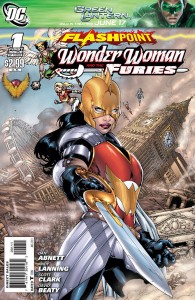
Written by Dan Abnett and Andy Lanning, I found Wonder Woman and the Furies #1 to be one of the most interesting of the tie-ins. It begins “fourteen years ago” on Themyscira, where a younger, more innocent Diana plans to secretly set out to sea so she can see the world beyond their shores. She’s attacked almost immediately, by a Kraken of all things, but is saved in the nick of time by good old Aquaman. Finding that she’s been poisoned by the monster’s venom, Arthur takes her back to Atlantis for treatment. This act of kindness starts the two ancient kingdoms’ relationship off on the right foot, but as we know, it all turns tragic. The rest of this issue covers the wedding in detail, and for the first time, we get to see exactly what (and who) sparked off the war; as I suspected early on, there’s more to the assassination than the world knows.
What I really like about this tie-in is that Diana and Arthur weren’t always the war leaders we’ve come to see them as in Flashpoint. Until the disaster at the wedding, both characters were actually a lot like they should have been—happy, optimistic, heroic, and both sort of carefree; although this is later spoiled by treachery and deceit, it makes me wonder if there’s a slim chance for peace in this timeline after all. I also really like Ed Benes and Peter Pantazis’ cover for the issue, which is a great shot of Wonder Woman in her war armor, standing in the ruins of London. The rest of the art is by Scott Clark and is of the same high quality I’m coming to expect from the comics in this event; the details on the backgrounds and scenery are especially good.
The final few I’ve saved till the end due to how different they are from the rest. While every other tie-ins feature alternate versions of characters we know (and a few altogether new ones), these three feature characters who, like Barry, aren’t really from this new timeline at all. The first of these is the Reverse-Flash tie-in, although to be fair, this issue seems to be mostly flashback and doesn’t directly take place in the Flashpoint event; this begs the question, of course, of what the point of it is. Is it just to bring people like me up to speed, or is there a hidden meaning in here somewhere? Time will tell, I suppose.
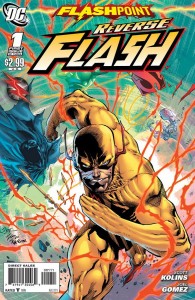
Reverse-Flash, a.k.a. Professor Zoom, a.k.a. Eobard Thawne, is an interesting character with an interesting, though slightly confusing backstory, which I’ll try to keep as brief as possible. Born far in the future, where spandex superheroes are only myth, Thawne was obsessed with the legendary Flash and, through studying him, managed to replicate his powers and become the fastest man alive in his time. Thawne is pretty unstable, though, and Barry Allen puts a stop to him; this of course leads to him becoming the villainous Reverse-Flash. In this issue, we see Thawne use his time travelling abilities to go into the past in attempts to exact revenge on his former idol. His first experiment is to prevent the accident that turned Barry into the Flash in the first place, but this proves to be disastrous for him; with no Flash in the past, he would never become the Reverse-Flash in the future, and would cease to exist Back to the Future style. Realizing this, Thawne takes it upon himself to travel further back and subtly ruin Barry’s childhood, hoping small changes during those years wouldn’t lead to his own non-existence. It seems to work, and the issue ends with him arriving at Barry’s home to kill his mother—something we know he succeeded in doing in the main timeline.
As I said, the main oddity about this issue is it’s all mostly things fans already know. If there’s a clue to the cause of the Flashpoint event hidden in here, it’s hidden well. Another oddity is that the cover calls this issue #1 of 3, but it’s apparently only a one-shot. This was another issue written by Scott Kolins, but this one was drawn by Joel Gomez. The art seems rougher around the edges than almost every other Flashpoint comic, but I kind of like it—particularly the backgrounds, which sometimes looked like water paintings. The cover was drawn by Ardian Syaf, Vicente Cifuentes, and Kyle Ritter, and shows Reverse-Flash destroying objects representing Batman, Wonder Woman, Superman and the rest as he runs, seeming to try to make us believe Thawne is responsible for all of Flashpoint…but I still have my doubts about that. The cover’s art doesn’t match the issue’s art at all, but that’s more of an observation than a criticism.

Next up is Kid Flash Lost #1. Starring Bart Allen, this one actually does take place within the Flashpoint event. The first thing to mention about the issue is that the cover is by Francis Manapul, which I’m beginning to spot right away thanks to his unique style; Manapul was the artist for most of the pre-Flashpoint Flash comics and will be drawing and writing the post-Flashpoint Flash comic after DC’s reboot, so it’s nice to see his take on the current, pre-reboot Bart here. The art inside, provided by Oliver Nome, is different, but by no means bad; again, it’s got the high amount of detail I’m coming to expect from this event. DC seems to have a lot of good artists these days.
The issue seems to begin with Bart trying to talk to Barry, who strangely keeps running from him. But this is all a trick. Noticing subtle mistakes, Bart uses his head and concludes that he’s trapped in a simulation—and once he’s realized that, waking up is a cinch. The young speedster finds himself in a strange lair, but isn’t concerned…that is, until he finds that his speed powers are gone. In fact, according to him, the Speed Force itself is gone…which, if true, is far worse than the situation Barry is in. The rest of the issue has Bart fending off an attack from the surprising owner of the lair, rescued by an unexpected ally, and discovering that he’s in some kind of Matrix-esque future. He realizes that the timeline has been tampered with and that without his speed force powers, nothing is protecting his existence; like Barry’s memories, Kid Flash himself may soon disappear. Of all the tie-ins so far, this is probably the one I’m most antsy to see more of, since it seems to be the one most likely to tell us what’s happened to the timestream. It was written by Sterling Gates, and I thought he did a good job of writing Bart’s part.

The tie-in I’ve saved until the very last was, ironically, the very first to be released. The reason I saved it for last is that it’s the most unusual: Booster Gold #44 and #45 are indeed Flashpoint tie-ins, but they’re also standard issues in the Booster Gold comic. Like Barry and Bart, the Booster here is exactly the same Booster from the original timeline; also like Barry, he finds himself in the middle of the Flashpoint world, and is quickly mistaken for some kind of Atlantean enemy by the United States government. Booster struggles to make sense out of what’s happening and believes he’s in some kind of alternate timeline, since time travelling is something he does regularly. When he and his robot Skeets try to return to their time, however, it doesn’t work, and Skeets’ conclusion really verifies things for us: they’re not in an alternate timeline—they’re in the only timeline.
Issue #44 ends with the arrival of an enemy Booster never wanted to run into again: Doomsday…or as they call him in this world, “Project Six”. This time he’s apparently under the control of the US military—under the control of General Nathaniel Adams, who was Captain Atom in the original timeline, to be precise. Anyone who knows anything about Doomsday can probably guess that this is not a brilliant idea, but it seems to be working for now, and Booster is forced to retreat while rescuing a somewhat reluctant damsel. The rest of issue 45 has him learning about the strange new world via the internet and coming to the same conclusion as Barry: that Reverse-Flash, whom he’d run into in the timestream not long ago, must be the one responsible for the changes in history.
Both Booster Gold issues were written and drawn by Dan Jurgens, who does an excellent job with both. I’d actually say the art may be some of the best I’ve seen in the event. Both covers are fantastic, featuring Booster prominently and several other characters and places in the backgrounds; in issue #44′s you can even see the Superman vault from Frankenstein and the Creatures of the Unknown. On top of that, the writing does an excellent job of introducing the character to someone like me who, despite knowing who Booster Gold is, has never read an actual Booster Gold comic before now. Like Kid Flash Lost, I feel like this comic has a high chance of actually explaining the Flashpoint event, since timelines are what Booster does for a living. Let’s just hope he lasts against Doomsday long enough to figure it all out.
As I said earlier, I definitely underestimated the scale of a DC event such as this. This has been my first time following an entire event, and even though DC’s issues are just over 20 pages long these days, reading and analysing every tie-in was a tougher task than I would have guessed. There’s so much information here that it’s sometimes hard to keep track of everything, and despite that, the biggest mysteries of Flashpoint still remain unsolved. But don’t think for a second that this deters me; at this point, I’m more curious than ever about how all of this is going to turn out.
After much ado, I find myself at the true middle of the story.
Flashpoint #3
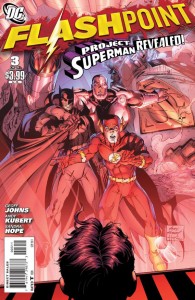
The issue starts with another cover by Andy Kubert. This one features Flash, Batman and Cyborg breaking through that big ol’ Superman vault door, all three of them looking shocked at what they find inside. The cover teases us by only showing the back of the occupant’s head, but the short black hair makes it clear that it’s Kal-El himself. He seems to be behind several inch thick glass, and the entire room is bathed in a red light; those who know a little about Superman will easily guess that this ill-boding glow is the sort of radiation you get from a red star, which robs Kryptonians of their special powers. The subtitle of the issue is present on this cover: Project Superman Revealed.
This is another good cover by Kubert. It once again chooses a couple of colors and sticks to them, which really seems to bring things together. Predictably, though, my dominant thought when I first saw it was whether Barry would finally get to be The Flash in this issue!
We join Cyborg as he converses with the U.S. president. As much as they’d like to, the government can’t spare any more time for Cyborg’s team to come together. Victor insists that sending in the U.S. military to try to break up a superhuman conflict would be disastrous, but with Steve Trevor presumed dead and the message he was carrying to the resistance presumably intercepted, their hands have been forced; they can’t wait any longer for Batman and the others to come to their senses and help out. Incidentally, it seems the counterspy Wonder Woman spoke of in issue #2 is Element Woman, whom we see sneaking about in his headquarters. Relieved of duty, Cyborg’s chance to save the world may be lost.
Meanwhile, back in Wayne manor, Barry is bandaged from head to toe and clearly in incredible pain…not surprising since he was electrocuted and covered in flaming chemicals. You would think this would be enough to deter anyone, but the first words out of Barry’s mouth are: “I need a bigger bolt of lightning.” Dr. Wayne thinks he’s crazy—which seems to be becoming the norm—but relents and lets him have it his way after listening to his reasoning. Barry knows that if he doesn’t get his powers back, his memories of the original timeline will soon be overwritten; he won’t even realize things aren’t the way they’re supposed to be anymore, nor will he remember his wife, or Thomas’ son. The two return to the roof, and before they can even strap Barry back into his chair, an enormous bolt of lightning hits him directly, blowing Batman off the roof in the process. But before the caped crusader can meet a grisly end on a spiked fence below, the moment we’ve been waiting for arrives: Barry rushes down the side of the manor as quick as lightning and plucks his fellow crime fighter from the jaws of death.
Finally, The Flash is back!
After using the Batcave’s chemicals to construct himself a new costume in a flash (haw), Barry uses Dr. Wayne’s rather disappointing personal computer—no super Bat-computer in this reality, apparently—to search for potential allies, much like Booster did. With Abin Sur still alive, Hal Jordan never became a Lantern, so Barry can’t risk putting him in danger; Wonder Woman and Aquaman are obviously out of the question; with such options unavailable, he asks the obvious question: where is Superman? Explaining the Kryptonian’s origin to Thomas, he repeats what we learned from the tie-ins: a rocket crashed into Metropolis at the time Barry specified, killing thirty-five thousand people. Not knowing what happened to the ship and its occupant after that, Batman calls the only person that can find out.
The two meet up with Cyborg, and Batman surprises him by agreeing to be the strategist in his army. His terms are simply that he gets to pick the members himself, beginning with The Flash and the occupant of the rocket, whom Cyborg will have to find by hacking government systems. Cyborg is against it, but he can’t pass up a chance at getting Batman, and thus others, on his team. They find the location of both the rocket and its occupant—“Subject 1”—and the rest of the issue covers their break in and discovery of the Kryptonian himself; what they come face to face with, however, is definitely not the Superman we’re used to…
Issue #3 has some interesting moments. The occupant of the rocketship is definitely Kal-El, but we can’t really call him Clark Kent; this Kal-El has been in a research facility his entire life, and thus was never raised by the Kents. Jonathan and Martha made Clark the man that he was, so it’s hard to guess what kind of guy he’ll turn out to be in this reality. We also learn that two more rockets were found after the first, which I presume must have belonged to Krypto and Kara; disturbingly, the three heroes happened to pass a room with a canine skeleton marked “Subject 2” on their way through the underground lab. Finally, it’s mentioned there’s a bridge in Central City that leads nowhere and that no one knows—or perhaps remembers—where it’s supposed to go; I wouldn’t have known this by myself, but this bridge is apparently meant to lead to Keystone City, the home of Jay Garrick. Not only that, but the villain known as The Fiddler once shifted Keystone City out of phase with the rest of the world to get revenge on Jay himself. That seems to be what’s happened here, but if Jay wasn’t The Flash in this reality, why did Keystone City still end up being hidden? Perhaps Jay was a Flash and is still there? I suppose time may tell.
I’m really starting to like Thomas Wayne as Batman, and his interactions with Barry—who’s practically his opposite—are a lot of fun. Barry is an unendingly hopeful optimist, just the kind of person the people of this Earth need right now. He even trusts that Kal-El’s heart will be the same no matter how much history has changed, and even though Dr. Wayne seems to think he’s insane and naïve most of the time, he’s still been persuaded to go along with him so far. My favorite moment between the two of them in this issue was when Barry voiced his disapproval at the way Thomas lied to Cyborg about joining his team—something the Batman doesn’t really plan on going through with; Dr. Wayne countered that if Barry succeeds at putting everything right, none of it will matter anyway. Issues written by Geoff Johns always seem to have a least one little exchange between the characters that I find myself liking. I know I’ve fixated a bit on Barry getting his powers back, but the truth is, Mr. Johns makes him a great character even without them.
Andy Kubert is once again the artist here. I’m finding it increasingly hard to have anything to say about his work, which just seems to be continuously flawless. It’s extremely detailed and easy to follow. In truth, it’s probably the best in the whole event, which makes sense since it’s the main book. What more can I say than that?
This issue gives us our first look at the Flashpoint version of Superman, once again designed by Kubert himself. Like a lot of things in the Flashpoint world, his appearance is bleak and depressing. They’ve got him wearing some sort of jumpsuit with an “S” on it, but it’s different to the Kryptonian one they slapped on the vault, and actually stands for “Subject 1”.
Like issue 2, #3 ends with more character designs from Mr. Kubert. Three of them are for characters from the British resistance: Lady Godiva, Mrs. Hyde, and Canterbury Cricket. These three characters were only in one panel of this issue, so it’s good to see their designs in more detail if you haven’t already seen them in the Canterbury Cricket one-shot; however, unlike the others so far, these three aren’t colored. Superman’s is, though, so you can get a better look at his design and read the brief notes on it here.
With this, we’re now halfway through the whole event. The first half has had some good parts and some average parts, but I find it hard to think of any bits that were outright bad. There were times where I thought an issue didn’t add much to the overall story, such as Grodd of War, Legion of Doom, and Captain Cold, but if you take all the tie-ins as a whole rather than individually, they serve to paint a much bigger picture, to give this world character and backstory, and to help immerse us in it. On the other hand, I think this means a lot of the tie-in issues may only interest people who, like me, are trying to follow the entire event, and that can obviously be an expensive task.
The writing may have had its ups and downs, but in my opinion, the art has been absolutely superb throughout. DC seems to have itself a lot of good artists these days, and it really feels like they’re giving it their all. The few pieces of art I haven’t really liked have been from some of the covers, which seems pretty odd to me. From my childhood, I remember comics always having fantastic covers to attract you, but mediocre art inside; here it sometimes feels like the other way around. There have, of course, been plenty of great covers as well, my favorites being by Dan Jurgens, Francis Manapul, and Andy Kubert. I hope this level of quality is kept up through the second half of the event.
If I had to make a prediction for what will happen next, I’d guess that we’re on the verge of unravelling the mystery. I believe the answers will start appearing in the first part of this second half, centering around Flashpoint #4. That will leave our heroes time to take action in the final fifth of the story. But what will their actions lead to? With a massive reboot occurring right as the Flashpoint event comes to a close, the solution to all of this seems as uncertain as ever.
Make sure to join us next time where I’ll be taking on the entire second half of the event. With two main issues and an even greater number of tie-ins on the way, it will undoubtedly be even more of a challenge for me!
Covers: B- (Some good ones, some not so good ones, but some great ones to make up for them.)
Writing: B (The writing seems to range between good and average to me, so a score somewhere in the middle of that seems reasonable.)
Art: A+ (Ranges from good to great. I can’t really think of any way they could have done better.)
Extras: B (Only Flashpoint #2 and #3 have really had proper extras, so I can only judge the event based on those. #2′s were better than #3′s.)
Overall (not an average): B+ (A very good event so far. The Flashpoint world has already become so detailed and fleshed out that it’s impossible not to be drawn into it. There was twists around every corner, constantly challenging your expectations, and it’s almost impossible not to sit around with fellow fans trying to solve the mysteries yourself.)
Since there are were so many issues covered here, we decided I should make some recommendations for people to check out. Like I said, it’s expensive to follow the whole event, so these are the tie-ins I think are worth checking out:
> Booster Gold #44 and #45. As I explained, this one is very like the main Flashpoint comics because it stars a character from the original timeline. They’re well drawn and have a good chance of revealing some of the event’s secrets.
> Kid Flash Lost #1. Pretty much the same as above. Manapul’s cover is very nice.
> Wonder Woman and the Furies #1. Out of all the flashbacks so far, I think this was the best. It showed us what Wonder Woman and Aquaman were like before their lives became nothing but war and obsession with revenge, and it shows us definitively how the war began.
> Batman: Knight of Vengeance #1 and #2. The first issue is n’t that great, but the second has one of the best surprise endings out of the whole event so far. Plus, with Batman playing an important role in the main book, this seems like a logical choice.
> Project Superman #1. With Kal-El making an appearance in Flashpoint #3, it seems like a good idea to learn his backstory here.
> Emperor Aquaman #1. Just if you want to know what really happened to Europe.
Everything else can probably be skipped for the most part, but there isn’t really anything bad enough for me to suggest avoiding at all costs. At worst, there are just a few that don’t seem very relevant to understanding the event. These are:
> Grodd of War. Not a bad one-shot, but so far Grodd’s actions don’t seem to have had much of an impact on the world at all.
> Legion of Doom #1. Does it really matter to the world that Heatwave is trying to escape from prison?
> Frankenstein and the Creatures of the Unknown #1. The story seems very isolated so far.
This comic was purchased at retail.
The mystery of the Flashpoint will continue…
Fanboy Review won’t have ads for the time being due to the legal issues between Amazon and the state of California. Enjoy!
The Flash and all related characters – © 2011 DC Comics. All Rights Reserved.

























